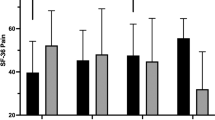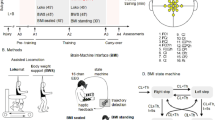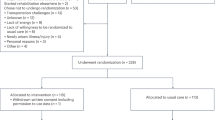Abstract
Study design
Health-related quality of life (HRQOL) data from two parallel independent single-blinded controlled randomized studies of manual (Study 1) and robotic (Study 2) locomotor training were combined (ClinicalTrials.gov #NCT00854555).
Objective
To assess effects of body-weight supported locomotor training (BWSLT) programs on HRQOL in persons with long-standing motor incomplete spinal cord injury and poor walking function.
Settings
Two inpatient rehabilitation facilities and one outpatient clinic in Norway.
Methods
Data were merged into intervention (locomotor training 60 days) or control group (“usual care”). Participants completed questionnaires before randomization and 2–4 weeks after the study period, including demographic characteristics, HRQOL (36-Item Short-Form Health Status Survey, SF-36), physical activity (The International Physical Activity Questionnaire Short Form, IPAQ-SF), exercise barrier self-efficacy (EBSE), and motivation for training (Behavioral Regulation in Exercise Questionnaire, BREQ). Physical outcomes i.e., Lower extremity motor score (LEMS) was assessed. The main outcome was change in HRQOL. Secondary outcomes included changes in IPAQ-SF, EBSE, BREQ, and physical outcomes.
Results
We recruited 37 of 60 predetermined participants. They were autonomously motivated with high baseline physical activity. BWSLT with manual or robot assistance did not improve HRQOL, though LEMS increased in the BWSLT group compared with control group.
Conclusions
The study was underpowered due to recruitment problems. The training programs seem to benefit LEMS, but not other physical outcomes, and had minimal effects on HRQOL, EBSE, and motivation. Autonomous motivation and high physical activity prior to the study possibly limited the attainable outcome benefits, in addition to limitations due to poor baseline physical function.
Similar content being viewed by others
Log in or create a free account to read this content
Gain free access to this article, as well as selected content from this journal and more on nature.com
or
References
Mehrholz J, Harvey LA, Thomas S, Elsner B. Is body-weight-supported treadmill training or robotic-assisted gait training superior to overground gait training and other forms of physiotherapy in people with spinal cord injury? A systematic review. Spinal Cord. 2017;55:722–9.
Wernig A, Muller S. Laufband locomotion with body weight support improved walking in persons with severe spinal cord injuries. Paraplegia. 1992;30:229–38.
Esclarín-Ruz A, Alcobendas-Maestro M, Casado-Lopez R, Perez-Mateos G, Florido-Sanchez MA, Gonzalez-Valdizan E, et al. A comparison of robotic walking therapy and conventional walking therapy in individuals with upper versus lower motor neuron lesions: a randomized controlled trial. Arch Phys Med Rehabil. 2014;95:1023–31.
Alcobendas-Maestro M, Esclarín-Ruz A, Casado-López RM, Muñoz-González A, Pérez-Mateos G, González-Valdizán E, et al. Lokomat robotic-assisted versus overground training within 3 to 6 months of incomplete spinal cord lesion: randomized controlled trial. Neurorehabil Neural Repair. 2012;26:1058–63.
Alexeeva N, Sames C, Jacobs PL, Hobday L, Distasio MM, Mitchell SA, et al. Comparison of training methods to improve walking in persons with chronic spinal cord injury: a randomized clinical trial. J Spinal Cord Med. 2011;34:362–79.
Adams MM, Hicks AL. Comparison of the effects of the body-weight-supported treadmill training and tilt-table standing on spasticity in individuals with chronic spinal cord injury. J Spinal Cord Med. 2011;34:488–94.
Wu M, Kim J, Wei F. Facilitating weight shifting during treadmill training improves walking function in humans with spinal cord injury: a randomized controlled pilot study. Am J Phys Med Rehabil. 2018;97:585–92.
Hitzig SL, Craven BC, Panjwani A, Kapadia N, Giangregorio LM, Richards K, et al. Randomized trial of functional electrical stimulation therapy for walking in incomplete spinal cord injury: effects on quality of life and community participation. Top Spinal Cord Inj Rehabil. 2013;19:245–58.
Hicks AL, Adams MM, Martin Ginis K, Giangregorio L, Latimer A, Phillips SM, et al. Long-term body-weight-supported treadmill training and subsequent follow-up in persons with chronic SCI: effects on functional walking ability and measures of subjective well-being. Spinal Cord. 2005;43:291–8.
Effing TW, van Meeteren NLU, van Asbeck FWA, Prevo AJH. Body weight-supported treadmill training in chronic incomplete spinal cord injury: a pilot study evaluating functional health and quality of life. Spinal Cord. 2006;44:287–96.
Quel de Oliveira C, Refshauge K, Middleton J, de Jong L, Davis GM. Effects of activity-based therapy interventions on mobility, independence, and quality of life for people with spinal cord injuries: a systematic review and meta-analysis. J Neurotrauma. 2017;34:1726–43.
Piira A, Lannem AM, Sørensen M, Glott T, Knutsen R, Jørgensen L, et al. Manually assisted body-weight supported locomotor training does not re-establish walking in non-walking subjects with chronic incomplete spinal cord injury: a randomized clinical trial. J Rehabil Med. 2019;51:113–9.
Piira A, Lannem AM, Sørensen M, Glott T, Knutsen R, Jørgensen L, et al. Robot-assisted locomotor training did not improve walking function in patients with chronic incomplete spinal cord injury: a randomized clinical trial. J Rehabil Med. 2019;51:385–9.
Waring WP 3rd, Biering-Sorensen F, Burns S, Donovan W, Graves D, Jha A, et al. 2009 review and revisions of the international standards for the neurological classification of spinal cord injury. J Spinal Cord Med. 2010;33:346–52.
Ware JE Jr., Sherbourne CD. The MOS 36-item short-form health survey (SF-36). I. Conceptual framework and item selection. Med Care. 1992;30:473–83.
Garratt AM, Stavem K. Measurement properties and normative data for the Norwegian SF-36: results from a general population survey. Health Qual Life Outcomes. 2017;15:51. https://doi.org/10.1186/s12955-017-0625-9.
Craig CL, Marshall AL, Sjöström M, Bauman AE, Booth ML, Ainsworth BE, et al. International physical activity questionnaire: 12-country reliability and validity. Med Sci Sports Exerc. 2003;35:1381–95.
McAuley E, Mihalko SL. Measuring exercise-related self-efficacy. In: Duda JL, editor. Advances in sport and exercise psychology measurement. Morgantown: Fitness Information Techn, Inc.; 1998. p. 371–81.
Deci EL, Ryan RM. The "what" and "why" of goal pursuits: human needs and the self-determination of behavior. Psychol Inq. 2000;11:227–68.
Nightingale TE, Rouse PC, Walhin JP, Thompson D, Bilzon JLJ. Home-based exercise enhances health-related quality of life in persons with spinal cord injury: a randomized controlled trial. Arch Phys Med Rehabil. 2018;99:1998–2006.
Saebu M, Sørensen M. Factors associated with physical activity among young adults with a disability. Scand J Med Sci Sports. 2011;21:730–8.
Costa R, Probst M, Bastos T, Vilhena E, Seabra A, Corredeira R. Behavioural Regulation in Exercise Questionnaire in people with schizophrenia: construct validity of the Portuguese versions. Disabil Rehabil. 2018;40:2577–84.
Lidal IB, Veenstra M, Hjeltnes N, Biering-Sorensen F. Health-related quality of life in persons with long-standing spinal cord injury. Spinal Cord. 2008;46:710–5.
International Physical Activity Questionnaire. Guidelines for data processing and analysis. https://sites.google.com/site/theipaq/home.
Norman GR, Sloan JA, Wyrwich KW. Interpretation of Changes in health-related quality of life: the remarkable universality of half a standard deviation. Med Care. 2003;5:582–92.
Kim CM, Eng JJ, Whittaker MW. Level walking and ambulatory capacity in persons with incomplete spinal cord injury: relationship with muscle strength. Spinal Cord. 2004;42:156–62.
Lam T, Noonan VK, Eng JJ, Team SR. A systematic review of functional ambulation outcome measures in spinal cord injury. Spinal Cord. 2008;46:246–54.
Lynch SM, Leahy P, Barker SP. Reliability of measurements obtained with a modified functional reach test in subjects with spinal cord injury. Phys Ther. 1998;78:128–33.
Gervasoni E, Jonsdottir J, Montesano A, Cattaneo D. Minimal clinically important difference of berg balance scale in people with multiple sclerosis. Arch Phys Med Rehabil. 2017;98:337–40.
Ditunno PL, Patrick M, Stineman M, Ditunno JF. Who wants to walk? Preferences for recovery after SCI: a longitudinal and cross-sectional study. Spinal Cord. 2008;46:500–6.
Acknowledgements
We thank the three primary rehabilitation centers for SCI in Norway, which have contributed to recruitment of the patients. We appreciate the cooperation with the patients’ organization LARS (National Association of the Spinal Cord Injured) and LTN (National Association of the Traffic Injured). The efforts of the staff, who conducted the body-weight supported locomotor training in Tromsø and Oslo and the work of the test team at Sunnaas Rehabilitation Hospital, are greatly appreciated.
Funding
The study has been financed with the aid of the Norwegian Health Authorities and “EXTRA” funds from the Norwegian Foundation for Health and Rehabilitation. Gjensidige insurance company donated the LOKOMAT® robot.
Author information
Authors and Affiliations
Contributions
AP, AML, KG, NH, RK, SFK, and MS have conceived the study. KG, RK, TG and SFK obtained funding for the study. AP, AML, KG, RK, NH, SFK, and MS participated in its design, all authors contributed (AP, AML, KG, RK, LJ, TG, NH, SFK, and MS) to coordination and manuscript drafting. All authors have read and approved the final manuscript.
Corresponding author
Ethics declarations
Conflict of interest
The authors declare that they have no conflict of interest.
Ethical statement
We ensured that this research was conducted with high ethical standards.
Additional information
Publisher’s note Springer Nature remains neutral with regard to jurisdictional claims in published maps and institutional affiliations.
Supplementary information
Rights and permissions
About this article
Cite this article
Piira, A., Lannem, A.M., Gjesdal, K. et al. Quality of life and psychological outcomes of body-weight supported locomotor training in spinal cord injured persons with long-standing incomplete lesions. Spinal Cord 58, 560–569 (2020). https://doi.org/10.1038/s41393-019-0401-2
Received:
Revised:
Accepted:
Published:
Issue date:
DOI: https://doi.org/10.1038/s41393-019-0401-2
This article is cited by
-
Clinical indications and protocol considerations for selecting initial body weight support levels in gait rehabilitation: a systematic review
Journal of NeuroEngineering and Rehabilitation (2024)
-
Combining robot-assisted therapy with virtual reality or using it alone? A systematic review on health-related quality of life in neurological patients
Health and Quality of Life Outcomes (2023)
-
Body weight-supported gait training for patients with spinal cord injury: a network meta-analysis of randomised controlled trials
Scientific Reports (2022)
-
The effects of active upper-limb versus passive lower-limb exercise on quality of life among individuals with motor-complete spinal cord injury
Spinal Cord (2022)



